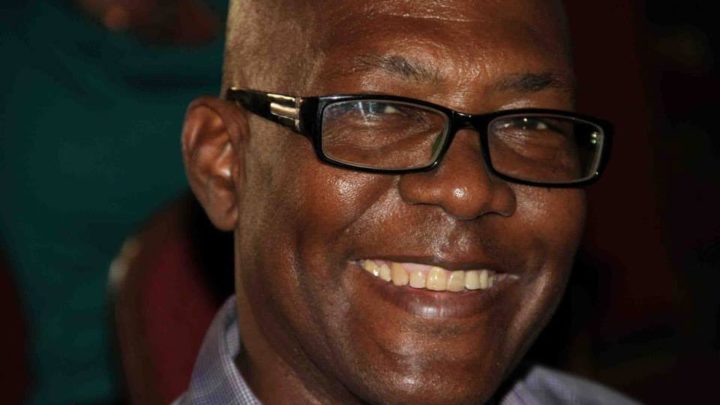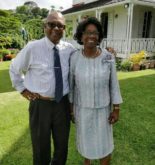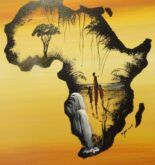When William Butler Yeats died in January 1939, W.H. Auden eulogized him as follows: “He disappeared in the dead of winter: The brooks were frozen, the airports almost deserted, And snow disfigured the public statues; The mercury sank in the mouth of the dying day. What instruments we have agree The day of his death was a dark cold day.
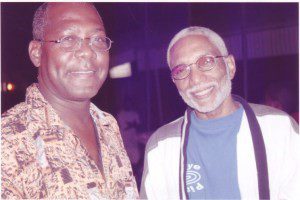
Gandolph St. Clair and John Robert Lee )
Far from his illness The wolves ran on through the evergreen forests, The peasant river was untempted by the fashionable quays; By mourning tongues The death of the poet was kept from his poems.
But for him it was his last afternoon as himself, An afternoon of nurses and rumours; The provinces of his body revolted, The squares of his mind were empty, Silence invaded the suburbs, The current of his feeling failed; he became his admirers.”
This is a short section of the longer poem. But given our recent cold and blustery weather, deep freezes in North America and Europe, the world and our own island seemingly on the brink of many political, social and cultural upheavals (Auden wrote in 1939 with the world on the brink of World War 2), death a growing, unsettling reality for those who are Gandolph’s generation – the words of this poem seemed appropriate.
Gandolph “Abbeystone” St. Clair was born April 3rd 1951. He passed away at the Victoria Hospital after a brief illness on Sunday February 11th.
He attended St. Aloysius R.C. Boys’ Infant and Primary, Vide Bouteille Government School, Choiseul R.C. Boys’ primary and St. Mary’s College. He studied at Brixton College and West Norwood Polytechnic in London between 1969-1971, and Burnhampthorpe Collegiate of Canada in 1994.
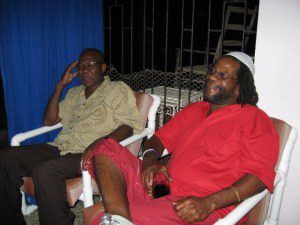
Gandolph St. Clair and the late Athanasius LaBorde
When he came to Castries to school, he lived with his uncle, Matthew “Abby” St. Clair, at 36 Coral Street, the legendary principal of the R.C. Boys’ School. Hence the nickname inherited by Gandolph, “Abby.”
In a moving short lyric in his last book “The Calabash tree,” Gandolph paid tribute to his uncle: “It has been many nights like this one/Listening to my heart’s reverberating tone/Thinking of this one great human being/who took me to his heart’s ever living/Showed me compassion and tenderness/In a way my own parents didn’t deliver…” (“Deaf Announcement”)
He was a St. Lucian writer, playwright, director, actor, singer, song-writer, pioneer film-maker, radio personality, community carnival organizer. Since his passing many callers to talk shows have remarked on his affability, calm demeanour, non-combative approach. Beneath that quiet exterior was a man who persisted with the many facets of his creative life, one who believed in the importance of arts and culture to the essential development of the nation. He was always writing – plays, songs, poems – and continued to contribute frequently to local newspapers.
I think he holds a unique place in our literary history when his overall body of work, his independent, idiosyncratic style, his themes, his wide interests, are considered. While our literature grows larger and wider, it still lacks close critical attention to separate quality and genuine achievement from all that appears. Gandolph’s work, like that of many of his contemporaries, has not had that kind of critical attention.
I first met Gandolph in the seventies. If memory serves right, he was introduced to me by Patricia Charles, then Extra Mural tutor and someone who gathered young writers, actors and playwrights into the Creative and Performing Arts Society and regular workshops at her offices on the Morne. He had been studying in England and was working in some kind of Government store-keeper’s job.
I search my thoughts to remake those early connections – our shared enthusiasm for literature and theatre, our work in our own theatre groups (he with his One Love theatre group and me with my New Day Theatre Workshop), our rapport within the thenrevolutionary movements coursing through the Caribbean and St. Lucia, reggae and
Rasta, our admiration of the work of Derek Walcott, Kamau Brathwaite and other cutting-edge writers of the Caribbean and beyond.
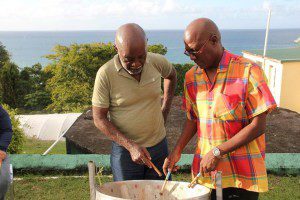
Actor Arthur Jacobs with Gandolph St. Clair
In the mid-seventies I was at Radio St. Lucia as an announcer, hosting an afternoon show “The Free and Easy time” in which I played reggae music, the new Soca and Cadence music, interviewed radical figures and international personalities passing through, including Little Richard, Lord Shortshirt and Jimmy Cliff among others. I was able to persuade the station management to bring Gandolph on also as an announcer. He soon became “Gandolph St. Clair, the man in the chair, the voice in the ear.” He featured the new music and musicians like Mervyn Wilkinson, Lennie Stone, Malcolm ‘Locks’ Magarron, Guyanese Keith Paul, veterans like Charles Cadet, the group Survival from Vieux Fort and other rising talents of the day. He had worked with these musicians as a singer and songwriter. His wide range of interests as a musician is reflected in his work with folk groups like The Helenites of Frank Norville and The Hewanorra Voices of Joyce Auguste.
His hit songs included “Let’s start a revolution” “Hence the reason” and “Love me.” He also sang calypso with the Soca Village calypso tent and helped with their management.
In those turbulent years, St. Lucia, like the Caribbean, was passing through its last colonial days, preparing for Independence and searching for its own voice and identity in many areas. The work of priest Patrick Anthony and the Folk Research Centre gave us a point of cultural focus. The left-of-centre politics of George Odlum gave us a political place to stand.
The journalism of the Crusader and the writings of Rick Wayne in his articles, the new Star newspaper and his book “It’ll be alright in the morning” gave young writers a literary target in terms of a kind of “new journalism” that fed into our plays, stories and poems. It was a great time to be young and talented and to be surrounded by high achievers like Derek Walcott, Sir Arthur Lewis, Bob Marley and other models.
With the example of McDonald Dixon, the first major literary voice to appear after the Walcott generation, writers like myself, Kendel Hippolyte, Gandolph, Portia Martial, Esther Mitchell, Melchoir Henry and others began to publish our own chapbooks using local printeries. Among those printeries was the Lithographic press owned by Mr. Augustus Justin, which was housed in the old Walcott home (recently refurbished as Walcott House.)
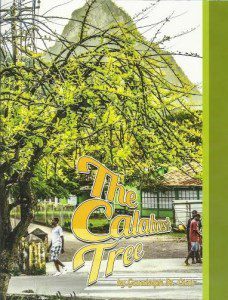 A native of Vieux Fort, Gandolph won a UNESCO bursary in 1979 to attend the Jamaica School of Drama, where he majored in Directing. His numerous credits include his own plays One Love, Guess who came to visit the Doctor, Bins and Tins, The Hustlers, (a one act play we wrote together and directed later by Hayden Forde which has been twice staged (2003 and 2005) and Just in case. Many of his plays won local and international awards.
A native of Vieux Fort, Gandolph won a UNESCO bursary in 1979 to attend the Jamaica School of Drama, where he majored in Directing. His numerous credits include his own plays One Love, Guess who came to visit the Doctor, Bins and Tins, The Hustlers, (a one act play we wrote together and directed later by Hayden Forde which has been twice staged (2003 and 2005) and Just in case. Many of his plays won local and international awards.
In Jamaica, he also directed Sir Gawain and the Green Knight; Kendel Hippolyte’s Drum maker, Errol John’s Moon on a rainbow shawl, The Harrowing of Benjy by Roderick Walcott among other Caribbean and international plays. He worked with well-known Caribbean playwrights and directors like Derek Walcott, Dennis Scott and Rawle Gibbons.
He was an accomplished actor, performing roles in Lorraine Hansberry’s Raisin in the sun; Shakespeare’s Julius Caesar; he gave a memorable performance as Jean Jacques Dessalines in stage and film versions of Derek Walcott’s The Haytian Earth, among others.
Gandolph was a local pioneer in film-making and radio drama. In 1999 he wrote and directed ‘A Twist in Time’, a forty three minute film, which has been shown locally and in St. Maarten at the Soulaiga Film Festival. He also wrote and produced the Radio Play “1+1+1” for Saint Lucia’s 15th Independence Anniversary.
He worked for many years at the Cultural Development Foundation, where he was Director of Carnival and was primarily responsible for the development of community carnivals. He travelled often to the French Caribbean islands to participate in their carnivals.
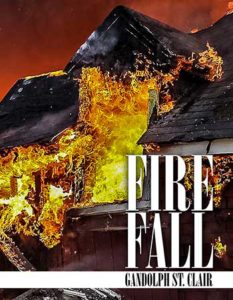 He also served as the CDF’s representative on the Nobel laureate Week Committee where he was responsible for organization of the annual Derek Walcott lecture. Here he came into contact with many well-known international writers including Seamus Heaney, Arthur Miller, Caryl Philips, Glyn Maxwell, Wole Soyinka, Sudeep Sen, Jamaica Kincaid among others. Since his death, many have written to comment on his kindness to them and helpfulness as he took them around St. Lucia.
He also served as the CDF’s representative on the Nobel laureate Week Committee where he was responsible for organization of the annual Derek Walcott lecture. Here he came into contact with many well-known international writers including Seamus Heaney, Arthur Miller, Caryl Philips, Glyn Maxwell, Wole Soyinka, Sudeep Sen, Jamaica Kincaid among others. Since his death, many have written to comment on his kindness to them and helpfulness as he took them around St. Lucia.
In 2013 he was field producer on the film “Poetry is an island, a documentary on Derek Walcott, directed by Ida Does.
In April 2014 the Central Library of Saint Lucia honored Gandolph for his invaluable contribution to the Literary Arts in Saint Lucia. In 2015 as part of the 36th Independent Anniversary celebrations, he was awarded the Saint Lucia Medal of Merit GOLD for long and dedicated contribution in the field of Culture and the Arts.
In 2016 he published his final book THE CALABASH TREE a collection of poetry, prose and drama.
In March 2017 the Saint Lucia Writers Forum hosted Gandolph in the Laureate’s Chair.
Gandolph published several collections of poetry, plays and prose:
The moon in daylight. Castries, Abbeystone Productions, 1987. 22p.
Urf song. Castries: Voice Press, 1984. 34p.
Reaching out: a first collection of poems. Castries: Abbeystone Publications, 1982. 17p.
The Calabash Tree. Castries: Abbeystone Productions, 2015. 58p.
Firefall. Castries: Abbeystone Productions, 2003. 29p.
“4-2 for true”. St. Lucia’s Independence Short Story. Castries: Abbeystone Productions, 1998. 18p.
Patent man [prose and poetry]. Castries: Abbeystone Productions, 1985. 21p.
The Third Umpire. Castries: Abbeystone Productions, 2013. 32p. ill.
Just in Case: The Hustlers & Just in case. Castries: Abbeystone Productions, 2007. [87pgs]. Ill.
One plus one plus one. 1989. [Radio drama].
Just in case. 1982. 24p. Broadcast, St. Lucia.
Z’affaire terre. 1981. 24p. Performed in St. Lucia. [Unp.] Bins and tins. 1980. 22p. Performed in St. Lucia. [Unp.]
Guess who came to visit the doctor. 1978. 14p. Performed by Gulf Theatre, New York.
One love. 1977. 12p. Performed in St. Lucia. Filmed for T.V.
Hustlers. 1976. 12p. Performed in 2003.
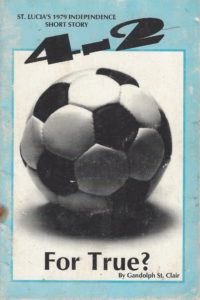 As happens, after our days together as young men, liming in the Graveyard with Ras Isheen and other social get-togethers in those safer, more innocent days, after our many hours together talking late into the nights of art, theatre, writers, politics and so on, after jamming reggae and soca and cadence music on Radio St. Lucia, after all that wonderful time of being centre stage in the arts and media of our country, we turned our attention to new families, job changes, travels, other interests. So we did not see as much of each other as we once did.
As happens, after our days together as young men, liming in the Graveyard with Ras Isheen and other social get-togethers in those safer, more innocent days, after our many hours together talking late into the nights of art, theatre, writers, politics and so on, after jamming reggae and soca and cadence music on Radio St. Lucia, after all that wonderful time of being centre stage in the arts and media of our country, we turned our attention to new families, job changes, travels, other interests. So we did not see as much of each other as we once did.
With Fish Alphonse we were together in Jamaica in the early eighties – he and Fish at the School of Drama and me at UWI, Mona. I remember meeting him at a poetry reading in Toronto in 1989 where he lived for a few years. In recent years, we often met during Nobel laureate Week activities. He was a close associate of Derek Walcott who involved him in projects of various kinds.
While I don’t recall him talking much about his exit from the CDF, others have said publicly that he was bitter about that, and felt that arts and artists were not given the support and recognition they deserved. Gandolph had become very private, listening more than talking. I can’t say I knew his political and religious views of later years.
But he continued his writing and publishing. He maintained his involvement in carnivals in the French Caribbean islands. He had served on the Board of ECCO (Eastern Caribbean Collective Organisation for music rights) from 2014-2016. Most recently, he represented the Walcott family at the showing of the film on Walcott, “Poetry is an island”, when it aired at a Barbados film festival.
We last met, perhaps appropriately, at the wreath-laying ceremony at the grave of Derek Walcott on Morne Fortune, on Friday January 26th. Gandolph had organized the wording of the plaque that lay on the plain tomb. Now, of course, I am trying to remember our last words to each other, how he looked, how we parted. Because as usual, we take these meetings of old friends so casually, so much for granted, assuming, foolishly that we will meet each other again, nothing remains. Except perhaps, that he was dressed in black and white.
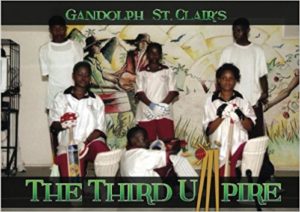
And we who are left, must face the present philistines and plantocrats who have scant regard for the arts and artists and culture of this country, who disregard the important work of the National Trust, who are bent on removing the National Cultural Centre, where Abby worked for many years, from its present place in the city, who make no efforts to ensure that our history, culture and literature are part of our schools’ curricula, and such other failures of necessary commitment to our development. The state of schools, hospitals, social services and small businesses and other such sore points concerned Abby St. Clair.
His words in his poem “Nugget” from his first collection of poetry titled “Reaching out” resonate again in the present circumstances of our national lives: “Some nights have no stars/Only the winged conspiracy of bats…obnoxious shadows/cultivate illusions..”
The Auden poem for Yeats carries the famous lines, “Poetry makes nothing happen.” I think Abby would have happily debated Auden on that. He believed that theatre, the arts and conscious media made things happen in the hearts and lives of his beloved Iyanola.
Adieu old friend, companion of many paths and tracks and stages. The struggle continues. We keep writing and singing and acting and dancing and painting and creating. Adieu Gandolph
 “Abbeystone” St. Clair, St. Lucian writer 1951-2018. Now the book is closed. R.I.P.
“Abbeystone” St. Clair, St. Lucian writer 1951-2018. Now the book is closed. R.I.P.
NOTE: John Robert Lee is a St. Lucian writer. His Collected Poems 1975-2015 was published by Peepal Tree Press in 2017.
![]()

